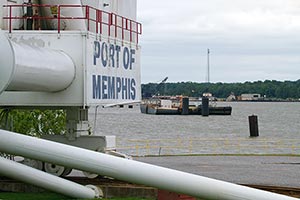Port of Memphis Plans Public Terminal Overhaul, Strategic Plan

The Port of Memphis isn't pretty, but it works. Bustling with oil and chemical storage tanks, warehouses, factories, trucks, trains and barges, it's where the heavy lifting of Memphis is done: manufacturing, steel fabricating, chemical and food processing and asphalt mixing.
It's out of sight, out of mind for most Memphians, but wheels are in motion to raise its profile as a prime industrial location and creator of jobs and economic output.
The city-county Port Commission has been seeking funding for a $50 million overhaul of its 63-year-old public dock, where river access has been severely curtailed since a series of high and low water events earlier this decade.
After missing out two years ago on a federal TIGER grant to start the overhaul, officials say the project could be resubmitted for funding under other federal programs later this year.
And the Port Commission, a unit of the city-county EDGE board (Economic Development Growth Engine of Memphis and Shelby County), is preparing to commission a strategic plan to look to the future and examine options such as more water access.
"I won't say the port is a well-kept secret. I think that's probably overstating it," EDGE chief executive Reid Dulberger said. "It's not something most people ever see and it's not a place most people ever go. But Memphis ... is a river town. There is much opportunity left on the river. We want to make sure we harvest as much of that as we possibly can."
Both the public dock project and the master plan would take into account the potential for river-borne movement of containerized freight, officials say.
The port consists of Presidents Island, Pidgeon Industrial Park and industries with direct access to the Mississippi River, McKellar Lake and the Wolf River Harbor.
A 2014 study by Younger Associates said the port served more than 135 businesses, supported 20,000 jobs and created $8.5 billion a year in economic impact. The nation's fifth-largest inland port, it handled 14.7 million tons of freight in 2014. Petroleum, food and farm products accounted for 53 percent of the volume.
EDGE and port officials say the public dock upgrade and strategic plan will address capacity issues that are holding back the port's growth.
"It provides real good industry jobs, high-paying jobs, and there's some real good opportunity out there," said Port of Memphis executive director Randy Richardson. But, "We're close to 100% capacity right now, definitely on the water frontage. It's getting harder and harder to find waterfront facilities and it's more expensive to make them because of the environmental hurdles involved today."

